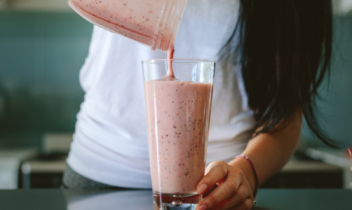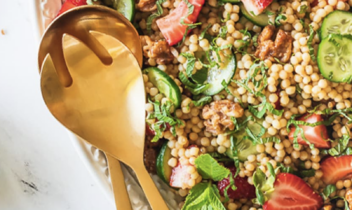
Should I Be Afraid Of The Dirty Dozen?
Answer
No, you shouldn’t fear any fruits or vegetables.
The Environmental Working Group (EWG) “Dirty Dozen” list is an annual list that ranks fruits and vegetables by what EWG deems as dangerous amounts of pesticide residues. In other words, an itemized list of 12 fruits and vegetables to demonize for the year.
We at PBH have taken a deep dive into the “Dirty Dozen” list and we’re breaking it down in simple terms to help alleviate any fears. We’ve done the homework for you, so you can feel good about eating fruits and vegetables for health and happiness, despite the EWG report.
The Science
The “Dirty Dozen” list is based on publicly available data from the United States Department of Agriculture (USDA). The USDA leads the Pesticide Data Program (PDP), a national initiative that samples food products and compiles information on pesticide residue levels. EWG uses this data to choose and rank the fruit and vegetable items on the “Dirty Dozen” list.
The latest USDA PDP report found more than 99 percent of the samples tested had residues well below the safety standards established by the Environmental Protection Agency (EPA) with almost half having no detectable pesticide residues at all.
The Criticism
The “Dirty Dozen” list has received criticism from many experts within the scientific community, and for good reason. We completed a comprehensive analysis into the methods used by the EWG to create this list. Our analysis reveals numerous issues, including:
- Flawed methodology;
- Incorrect findings and misleading messaging; and
- Inconsistencies with authoritative bodies, including several government agencies and respected academic experts.
Irresponsible data interpretation is not the only issue at play. The real offense is that the report is sparking fear about eating fruits and vegetables, when global government agencies, health organizations, scientists, and public health advocates agree that fruit and vegetable intake must be increased. And, the data backs this up.
The Dietary Guidelines for Americans have recommended increased intake of fruits and vegetables since its inception in 1980—implying that Americans are not consuming enough. Food intake surveys validate this, demonstrating a chronic, consistent and persistent gap between consumption and recommendations that spans decades.
While public health experts agree that consumers should increase their intake of fruits and vegetables, continuous efforts to encourage greater consumption have been unsuccessful, and intake remains well below recommendations. Meanwhile, groups such as the EWG that have consumers’ ear, whether intentional or not, are working against this recommendation.
The “Dirty Dozen” list, published since 2004, invokes unsubstantiated fear that is counterproductive to helping Americans eat more fruits and vegetables. Period.
What We Know About The Benefits Of Fruits & Vegetables
In short, fruits and vegetables, regardless of type or form (fresh, frozen, canned, dried and 100% juice) as well as production methods, are closely associated with a multitude of health and well-being benefits. Decades of research and numerous studies confirm that increasing consumption of produce—both conventional and/or organic—improves health and reduces the risk of chronic disease and mortality. For instance, it has been estimated that, if just half of all Americans increased their consumption of a fruit or vegetable by a single serving each day, 20,000 cancer cases could be prevented every year.
Currently, nine out of 10 Americans are not consuming the recommended levels of fruits and vegetables. That fact demonstrates A LOT of room for improvement.
What We Know About Pesticides In Produce
Two U.S. government agencies’ findings contradict the EWG’s claims. USDA’s Pesticide Data Program employs a rigorous statistical design so that its data for measuring exposure to pesticides can be used to assess the safety of the food supply. As noted previously, findings in its 2020 report indicate that more than 99% of samples tested had residues well below the tolerances established by the Environmental Protection Agency (EPA). Additionally, data from the Food & Drug Administration (FDA) shows that close to 50% have no detectable pesticide residue at all. Finally, a peer reviewed study found that EWG’s suggested substitution of organic forms of produce for conventional forms did not result in any decrease in risk because residues on conventional produce are so minute, if present at all.
Sometimes, the simple answer is the right answer. According to the FDA, washing produce under running tap water can reduce and often eliminate pesticide residues, if they are present at all.
We Can (& Have To) Do Better
Sure, the “Dirty Dozen” is sensationalistic and might command media coverage. But, does it really help consumers know what healthful behaviors they should prioritize and how to do it? No.
The single most important action we can take today to positively impact our health and happiness is to eat more fruits and vegetables. Period.
Want to learn more? Here are some more resources to check out:

Leslie Bonci, MPH, RD, CSSD Blog post: No Need To Reduce, It’s Time To Boost! Let’s Cheer, Not Fear Fruits & Veggies

Neva Cochran, MS, RDN, LD, FAND Blog post: Same Song, Second Verse: The Dirty Dozen is Still a Dirty Lie

Cara Harbstreet, RD Blog Post: Safe Fruits and Veggies for All: Simple Substitutes for Cooking at Home

Manuel Villacorta, MS, RD Video: Facts Not Fears About Organic vs. Conventional Produce

Taylor Wallace, PhD, CFS, FACN: A Message from Conventional Fruits and Veggies: BITE ME

Joan Salge Blake, EdD, RDN, LDN, FAND: Keeping Your Mind and Body Healthy During Quarantine



